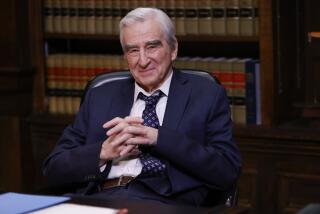A Role That’s a Matter of Life and Death for Bruce Davison : Movies: His award-winning portrayal of a father figure in ‘Longtime Companion’ helps humanize the tragedy of AIDS.
Bruce Davison is starring in the television series “Harry and the Hendersons” at Universal. He also has an Academy-Award nomination to add to his Golden Globe and New York Film Critics award as best supporting actor for his role as a kind of father figure to a group of gay friends in “Longtime Companion.” It suggests an acting career that even by prevailing norms has taken him to wide extremes.
Davison made a notable debut in 1969 as one of a quartet of bored and sex-infatuated teen-agers summering on Fire Island in Frank and Eleanor Perry’s “Last Summer,” from the Evan Hunter novel. Co-stars Barbara Hershey and Richard Thomas have also been heard from since, to say the least. Cathy Burns, who received an Oscar nomination for her performance, drifted away from acting into writing, and Davison said the other afternoon that Burns has a new script that is regarded as a hot property around town.
Davison’s other feature credits range as widely as “Mame,” Ken Russell’s kinky “Crimes of Passion,” “The Strawberry Statement” (about the student riots at Columbia University in the late ‘60s), “Willard” (in which he co-starred with hundreds of rats) and “Short Eyes” (in which he played a child molester in the Tombs Prison in Manhattan).
“My kid sister was 12 before she was allowed to see a movie I’d made,” Davison says with a wry grin.
Raised in Philadelphia, Davison was sent to Miami (Fla.) Military Academy, “where we watched through barbed wire as pretty girls went water skiing by.” At Penn State he majored in art, then wandered into an open audition for a campus production of “Come Back Little Sheba.” He wasn’t cast but went back again and got a role in “O Dad Poor Dad.”
“The first time I made 600 people laugh, I was hooked,” he says. They were laughing because he couldn’t get his fly zipped, but no matter. Soon flunking out of everything and regarded as bizarre because he loped across campus muttering his lines, he switched in 1966 to New York University’s new school of performing arts, where his classmates included Barry Bostwick, Bud Cort and Mary Beth Hurt.
He hit Broadway in Anthony Quayle’s production of “Tiger at the Gate,” followed by a minuscule part in Lee J. Cobb’s “King Lear.”
The first film, “Last Summer,” gave him an optimistic view of filmmaking. “We all got to collaborate with Frank and Eleanor. I didn’t know that wasn’t the way it’s done. The next time out I was told to mind my own business.”
Twenty years later, filming scenes for “Longtime Companion” on Fire Island, he was within a stone’s throw of the dunes where they had shot “Last Summer.”
Davison, married to actress Lisa Pelikan, had done Larry Kramer’s play “The Normal Heart” in Los Angeles, co-starring as a dying AIDS victim with Richard Dreyfuss. He also starred in television’s first drama about AIDS, “An Early Frost.” Portraying the central stabilizing figure in “Longtime Companion” was thus appealing not least because he had seen the positive impact the earlier dramas had had in humanizing a tragedy that had initially evoked more fear and hostility than sympathy.
“And it was so beautifully written,” Davison says. “All the pauses were in the script.” (He referred to a scene in the film in which his own longtime companion is dying and Davison says, with gentle urgency, “Let go. . . . Let go.” The script is by Craig Lucas, directed by Norman Rene. The dying companion was played by Mark Lamos, artistic director of the Hartford Stage, where Davison hopes one of these days to do “Richard III.”
Of “Longtime Companion,” he says: “I feel like a speck caught in a giant wave. There are people living that life every day. During ‘The Normal Heart,’ there would be guys in the back in wheelchairs, sobbing. Now it’s a double satisfaction to have these awards because they are awards for the picture too, and it’s the impact of the picture that matters.”
More to Read
Only good movies
Get the Indie Focus newsletter, Mark Olsen's weekly guide to the world of cinema.
You may occasionally receive promotional content from the Los Angeles Times.










